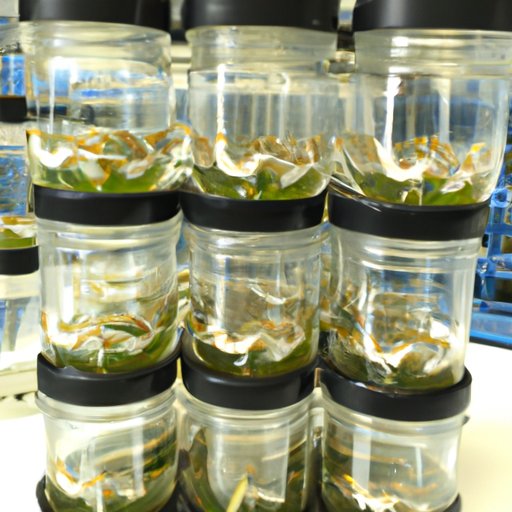Introduction
Tissue culture planting is a form of plant propagation that involves the use of small pieces of plant tissue, known as explants, to grow new plants in a sterile environment. It is an effective way to propagate plants quickly and reliably. This article will provide a comprehensive guide to tissue culture planting, including a step-by-step guide to the process, information on how to use tissue culture to propagate plants, and a beginner’s guide to tissue culture planting.
Step-by-Step Guide to Tissue Culture Planting
Tissue culture planting begins with setting up the environment. This includes selecting a suitable space, such as a laboratory or greenhouse, and creating a sterile environment by sanitizing all equipment and surfaces. Next, explants are harvested from the parent plant and prepared for culture. Explants are small pieces of plant tissue, such as leaves, stems, or roots. The explants are then sterilized to reduce the risk of contamination. Once the explants have been sterilized, they can be transferred to a culture medium, which is a nutrient-rich solution designed to promote the growth of the explant.
The explants are then grown and maintained in the culture medium. This involves monitoring the cultures for signs of contamination, adjusting the pH and nutrient levels of the medium, and ensuring that the cultures are receiving adequate light, water, and air. Once the cultures have grown to a certain size, they can be transferred to individual containers for further growth or used to propagate new plants.

How to Use Tissue Culture to Propagate Plants
Propagation is the process of producing new plants from existing ones. There are several different types of plant propagation, and tissue culture is one of the most reliable methods. Tissue culture propagation involves taking explants from a parent plant and growing them in a sterile environment. Once the explant has grown to a certain size, it can be used to propagate new plants. This can be done by separating the explant into smaller pieces and transferring them to individual containers, or by directly transferring the explant to soil or another substrate.
Tissue culture propagation has several advantages over other methods of propagation. For example, it is faster than traditional propagation techniques, as it does not require waiting for seeds to germinate or for cuttings to take root. It also allows for greater uniformity in the plants produced, as all of the propagated plants will be genetically identical. Additionally, tissue culture propagation can produce disease-free plants, as the explants are grown in a sterile environment.
A Beginner’s Guide to Tissue Culture Planting
Tissue culture planting can seem daunting at first, but with the right knowledge and preparation, anyone can successfully propagate plants using this method. To get started, it is important to understand the basics of tissue culture. This includes understanding the different types of explants, the components of the culture medium, and the specific steps involved in the process.
Once you have a basic understanding of tissue culture, you can begin preparing the culture environment. This involves selecting a suitable space and setting up the necessary equipment, such as incubators, laminar flow hoods, and microscopes. You will also need to purchase the necessary supplies, such as culture medium, explants, and sterilization materials.
Next, you will need to select the right explants for your project. Different plants require different explants, so it is important to research the plant species you are working with and select explants that are well suited for the task. Once you have the explants, you will need to prepare them for culture by sterilizing them and transferring them to the culture medium.
Finally, you will need to set up the explants in the culture medium and monitor and maintain the cultures. This involves regularly checking the cultures for contamination, adjusting the pH and nutrient levels of the medium, and ensuring that the cultures are receiving adequate light, water, and air. With regular maintenance, your cultures should grow healthily and be ready to use for propagation.
Exploring the Benefits of Tissue Culture Planting
Tissue culture planting has many advantages over traditional methods of propagation. One of the most significant benefits is the increased speed of propagation. Tissue culture propagation can produce new plants in a much shorter time frame than traditional propagation techniques, such as seed germination or cuttings. This is due to the fact that the explants are grown in a sterile environment, so there is no need to wait for the explants to take root or for the seedlings to mature.
Another benefit of tissue culture propagation is cost savings. It is much more cost-effective than traditional methods of propagation, as it requires fewer resources and less labor. Additionally, tissue culture propagation enables growers to produce plants with greater uniformity, as all of the propagated plants will be genetically identical. Finally, tissue culture propagation is the only method of propagation that can produce disease-free plants, as the explants are grown in a sterile environment.
Conclusion
Tissue culture planting is an effective and reliable method of plant propagation. It is faster than traditional methods of propagation, and it allows for greater uniformity and cost savings. Additionally, it is the only method of propagation that can produce disease-free plants. This article has provided a comprehensive guide to tissue culture planting, exploring the step-by-step process, the benefits of using this method for propagation, and tips for beginners.
(Note: Is this article not meeting your expectations? Do you have knowledge or insights to share? Unlock new opportunities and expand your reach by joining our authors team. Click Registration to join us and share your expertise with our readers.)
